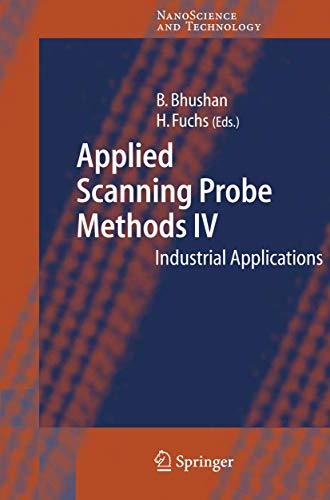Applied Scanning Probe Methods IV: Industrial Applications (NanoScience and Technology) - Softcover

"synopsis" may belong to another edition of this title.
From the reviews:
"The editors have done a good job in making the various chapters quite readable and most of the chapters are well written on a level that will be accessible to most readers. ... As is usually the case with Springer books, these volumes have been beautifully printed, illustrated, and nicely bound for long term durability." (Gary J. Long & Fernande Grandjean, Physicalia Magazine, Vol. 29 (4), 2007)
"About this title" may belong to another edition of this title.
- PublisherSpringer
- Publication date2010
- ISBN 10 364206597X
- ISBN 13 9783642065972
- BindingPaperback
- Number of pages328
- EditorBhushan Bharat, Fuchs Harald
Buy New
Learn more about this copy
Shipping:
FREE
Within U.S.A.
Top Search Results from the AbeBooks Marketplace
Applied Scanning Probe Methods IV: Industrial Applications (NanoScience and Technology) by Various, . [Paperback ]
Book Description Soft Cover. Condition: new. Seller Inventory # 9783642065972
Applied Scanning Probe Methods IV : Industrial Applications
Book Description Condition: New. PRINT ON DEMAND Book; New; Fast Shipping from the UK. No. book. Seller Inventory # ria9783642065972_lsuk
Applied Scanning Probe Methods IV: Industrial Applications (NanoScience and Technology)
Book Description Condition: New. Seller Inventory # ABLIING23Mar3113020215702
Applied Scanning Probe Methods IV
Book Description Condition: New. Dieser Artikel ist ein Print on Demand Artikel und wird nach Ihrer Bestellung fuer Sie gedruckt. First book summarizing the state of the art of this techniqueReal industrial applications includedScanning Probe Lithography for Chemical, Biological and Engineering Applications.- Nanotribological Characterization of Human Hair and Skin U. Seller Inventory # 5045698
Applied Scanning Probe Methods IV
Book Description Taschenbuch. Condition: Neu. This item is printed on demand - it takes 3-4 days longer - Neuware -The Nobel Prize of 1986 on Sc- ningTunnelingMicroscopysignaled a new era in imaging. The sc- ning probes emerged as a new - strument for imaging with a p- cision suf cient to delineate single atoms. At rstthere were two the ScanningTunnelingMicroscope,or STM,andtheAtomicForceMic- scope, or AFM. The STM relies on electrons tunneling between tip and sample whereas the AFM depends on the force acting on the tip when itwasplacednearthesample.These were quickly followed by the M- netic Force Microscope, MFM, and the Electrostatic Force Microscope, EFM.TheMFMwillimageasinglemagneticbitwithfeaturesassmallas10nm. WiththeEFMonecanmonitorthechargeofasingleelectron.Prof.PaulHansma atSantaBarbaraopenedthedoorevenwiderwhenhewasabletoimagebiological objects in aqueous environments. At this point the sluice gates were opened and amultitudeofdifferentinstrumentsappeared. There are signi cant differences between the Scanning Probe Microscopes or SPM, and others such as the Scanning Electron Microscope or SEM. The probe microscopes do not require preparation of the sample and they operate in ambient atmosphere, whereas, the SEM must operate in a vacuum environment and the sample must be cross-sectioned to expose the proper surface. However, the SEM canrecord3Dimage andmovies, featuresthatarenotavailable withthescanning probes. TheNearFieldOpticalMicroscopeorNSOMisalsomemberofthisfamily.At thistimetheinstrumentsuffersfromtwolimitations;1)mostoftheopticalenergy is lost as it traverses the cut-off region of the tapered ber and 2) the resolution is insuf cient for many purposes. We are con dent that NSOM s with a reasonable opticalthroughputandaresolutionof10nmwillsoonappear.TheSNOMwillthen enterthemainstreamofscanningprobes. VI Foreword In the Harmonic Force Microscope or HFM, the cantilever is driven at the resonantfrequencywiththeamplitudeadjustedsothatthetipimpactsthesampleon each cycle. Theforcesbetween tipandsample generate multiple harmonics inthe motionofthecantilever.Thestrengthoftheseharmonicscanbeusedtochar acterize thephysicalpropertiesofthesurface. 328 pp. Englisch. Seller Inventory # 9783642065972
Applied Scanning Probe Methods IV : Industrial Applications
Book Description Taschenbuch. Condition: Neu. Druck auf Anfrage Neuware - Printed after ordering - The Nobel Prize of 1986 on Sc- ningTunnelingMicroscopysignaled a new era in imaging. The sc- ning probes emerged as a new - strument for imaging with a p- cision suf cient to delineate single atoms. At rstthere were two the ScanningTunnelingMicroscope,or STM,andtheAtomicForceMic- scope, or AFM. The STM relies on electrons tunneling between tip and sample whereas the AFM depends on the force acting on the tip when itwasplacednearthesample.These were quickly followed by the M- netic Force Microscope, MFM, and the Electrostatic Force Microscope, EFM.TheMFMwillimageasinglemagneticbitwithfeaturesassmallas10nm. WiththeEFMonecanmonitorthechargeofasingleelectron.Prof.PaulHansma atSantaBarbaraopenedthedoorevenwiderwhenhewasabletoimagebiological objects in aqueous environments. At this point the sluice gates were opened and amultitudeofdifferentinstrumentsappeared. There are signi cant differences between the Scanning Probe Microscopes or SPM, and others such as the Scanning Electron Microscope or SEM. The probe microscopes do not require preparation of the sample and they operate in ambient atmosphere, whereas, the SEM must operate in a vacuum environment and the sample must be cross-sectioned to expose the proper surface. However, the SEM canrecord3Dimage andmovies, featuresthatarenotavailable withthescanning probes. TheNearFieldOpticalMicroscopeorNSOMisalsomemberofthisfamily.At thistimetheinstrumentsuffersfromtwolimitations;1)mostoftheopticalenergy is lost as it traverses the cut-off region of the tapered ber and 2) the resolution is insuf cient for many purposes. We are con dent that NSOM s with a reasonable opticalthroughputandaresolutionof10nmwillsoonappear.TheSNOMwillthen enterthemainstreamofscanningprobes. VI Foreword In the Harmonic Force Microscope or HFM, the cantilever is driven at the resonantfrequencywiththeamplitudeadjustedsothatthetipimpactsthesampleon each cycle. Theforcesbetween tipandsample generate multiple harmonics inthe motionofthecantilever.Thestrengthoftheseharmonicscanbeusedtocharacterize thephysicalpropertiesofthesurface. Seller Inventory # 9783642065972

